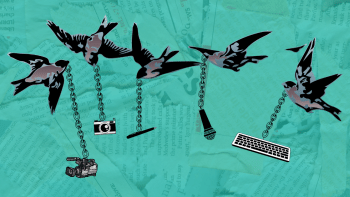How can Bangladesh have sustainable journalism and media self-regulation?

There is a broad consensus among academics, researchers and media practitioners all over the world that the long-standing legacy of journalism has come under severe strains from various internal and external factors. Bangladesh is no exception to this global trend. This calls for serious rethinking about the sustainability of this important profession, known as the vanguard of democratic principles, freedom of expressions and citizens' right to know.
Under an international media fellowship programme named "Media Regulation in a Democratic Framework," organised by NIRAS Sweden, FOJO Media Institute, Global Reporting Sweden, and International Media Support, a team of six professionals from Bangladesh comprising journalists, educators and leaders of national and international media CSOs were invited to Sweden in May this year to learn first-hand about these issues. Vietnam, Cambodia and the Philippines are also participating in this one-year fellowship programme.
The concept of sustainable journalism started taking shape in 2017 when three Western researchers – P Berglez, U Olausson, and M Ots – suggested integrating environmental, social, and economic challenges of journalism. This particular angle of linking quality journalism with three pillars of sustainable development (economic growth, environmental protection and social equality) became popularly known as sustainable journalism. Lars Tallert, a leading advocate of the concept, observed that sustainable journalism "regards journalism as a lever for sustainability." He also suggested that transparency was a precondition for sustainable journalism.
The concept of sustainable journalism is yet to get currency in Bangladesh; however, another term named "development journalism" was prevalent in the mid-80s. During the 1990s, the issues of political corruption, transparency, and accountability gaps in the planning, implementation and monitoring of various government projects came under media spotlight in Bangladesh. Some researchers also focused on public trust issues, questioning the decline of the media's own credibility in the public eye, for toeing the official line, instead of conducting public-interest journalism. A recent study of Management and Resources Development Initiative (MRDI) found that factual quality reporting in news is only one factor that determines media trust. For Bangladesh's news media users, "trust is based on a complex mix of factors, including tradition, availability, personal economics, and personal relationships – among many others."

For this international fellowship programme, the Bangladesh team's assumption was that "the practice of quality journalism for increasing the public trust in media leads to its business viability." This assumption is based on the general perception that Bangladeshi media has been losing the public trust for various reasons.
Three focus group discussions (FGDs) were carried out for the purpose of the Bangladesh study. Participants included journalism educators, professional journalists and media leaders representing various journalist associations and forums. Among 26 participants, 22 were male and four female. In addition, five key informants' interviews (KIs) were also conducted involving two English newspaper editors, one executive editor of a TV channel, one executive director of an INGO, and a senior female reporter of a leading Bangla daily.
The findings of this study are: a) the concept of sustainable journalism in Bangladesh is varied among various stakeholders and not aligned with the international standards and benchmarking; b) Bangladesh media leaders and professionals are worried about the declining media trust. However, they tend to put the blame mostly on the external factors, sidelining the media's own failures in maintaining effective internal governance standards; and c) there is a strong urge from media leaders and practitioners to develop functional media code of conduct and improving self-regulations.
It also transpired during those FGDs and KIs that media leaders are unable to implement media self-regulation or practise sustainable journalism for several reasons. First, the idea of sustainable journalism is not endorsed by the media owners or entrepreneurs, who received media licences using political connections. So, their loyalty is towards the political masters only, not to the readers or audiences. Second, some senior media leaders are aware of the need for practising sustainable journalism, but cannot do so because of overpoliticisation of the profession. Third, a majority of the participants are not fully aware about global practices on media self-regulation issues. For example, the media ombudsperson concept as widely practised elsewhere is seemingly unheard of in Bangladesh. One online Bangla outlet introduced an in-house ombudsperson and it was widely hailed as a trend-setter. Later, it was revealed that this was done to attract foreign grants. Once it was secured, the post became ineffectual.
Some forms of media self-regulation exist in Bangladesh, with little practice or no knowledge about it. For example, Bangladesh has a Code of Conduct initiated by the government through the Bangladesh Press Council in 1993. There is a component under this code of conduct that outlined several indicators known as Form Ka (Form A), covering objectivity, impartiality and integrity issues, which a new journalist needs to sign before commencing duties. Unfortunately, not many new journalists are aware of this form, nor is there any evidence that would suggest that media managements are eager to implement it.
Few newspapers have their own editorial guidelines, but they are not publicly available. Only one Bangla daily has its own style guide in following the spellings. In terms of the media's own transparency and accountability mechanism, there is a serious governance deficit in Bangladesh's media sector. For example, assets and balance sheets are not disclosed to the public or income from official advertising reported. On the other hand, except a few leading media houses, not many journalists get paid on time regularly, and bonus or festival allowances are issues to be frowned upon by many media owners.
Bangladesh should tap into mainstreaming sustainable journalism through actionable media self-regulations. A collaborative approach involving all relevant stakeholders is needed to make a strong footprint of sustainable journalism in Bangladesh. In the recently-concluded first-ever Sustainable Journalism Partnership Conference in Sweden, it was agreed that MRDI and the FOJO Media Institute of Sweden would soon set up a Sustainable Journalism Centre in Bangladesh.
Some of the suggested action plans could be: a) developing an editorial guideline and making it public; b) be inclusive and practise diversity in newsroom; c) develop gender policy; d) set up an "accuracy cell" to monitor fairness and balance in news reporting; e) appoint in-house media ombudsperson; f) introduce readers/audience segment called "Face the Readers/Audience" and respond to queries from the public on a quarterly basis; g) introduce "Reporter of the Month" awards, appoint a focal point on the right to information; and h) disclose financial balance sheet online. This is also an opportunity for Bangladeshi media houses to improve their internal governance system.
What is more important now is that media leaders in Bangladesh must introduce some form of "inward" or "outward" self-regulatory mechanism to adhere to basic professional standards of accuracy and fairness to regain public trust.
SM Rezwan Ul Alam, PhD, is associate professor of media and journalism at North South University (NSU).

 For all latest news, follow The Daily Star's Google News channel.
For all latest news, follow The Daily Star's Google News channel. 









Comments